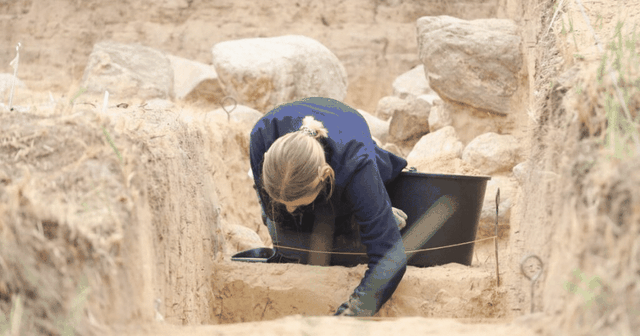
'Massive prehistoric pyramids' discovered in Poland shed light on ancient engineering


In an extraordinary archaeological discovery, two megalithic tombs, over 5,500 years old, have been discovered in western Poland.
These monumental structures, often referred to as the “Polish pyramids” or “giants' tombs,” offer new insights into the engineering and burial practices of one of Europe's earliest agricultural societies.
The discovery, made by archaeologists from Adam Mickiewicz University in Poznań, provides evidence of the advanced construction methods and astronomical understanding possessed by ancient Funnelbeaker Culture communities.
Located in the village of Wyskoć, within the General Dezydery Chłapowski Landscape Park in the Wielkopolska province, the tombs reveal a level of architectural sophistication that challenges traditional assumptions about early human societies. These tombs are not only impressive in scale, but also symbolize the cultural and spiritual practices of a community that left behind some of the earliest monumental structures in Europe.
The site is managed and protected by the Zespół Parków Krajobrazowych Województwa Wielkopolskiego, the organization that oversees the park's conservation and ensures ongoing research into the archaeological significance of the region.
The newly discovered tombs are some of the largest and most elaborate prehistoric burial monuments in Poland, measuring up to 200 meters long and about four meters high. Their trapezoidal shape, with wide, raised eastern fronts that taper into low western “tails,” reflects an intricate understanding of spatial design. The alignment of these structures with the cardinal directions further emphasizes the advanced knowledge of astronomy possessed by the Funnelbeaker Culture. Such an achievement required not only engineering brilliance, but also an understanding of celestial events and their possible religious or symbolic meanings.
The engineering of these tombs is a testament to the ingenuity of Neolithic people. The massive stones surrounding these structures, some weighing up to 10 tons, were likely transported using simple mechanical devices.
Despite the lack of modern technology, these ancient builders managed to move and position large stones with impressive precision. While much of the stonework has been reused over the centuries, remnants of this engineering marvel still stand, offering a glimpse into the technological capabilities of the time.
The tombs were likely used to bury individuals of high social or spiritual importance, such as tribal leaders, shamans, or priests. This suggests that while the Funnelbeaker Culture may have been relatively egalitarian, some members of the community played prominent roles in its spiritual and political life. Within these tombs, archaeologists expect to find burial objects such as pottery, stone axes, and copper ornaments, which provide clues about the material culture and belief systems of the time.
The positioning of the bodies within the tombs also reveals key aspects of Neolithic burial practices. The bodies were likely placed on their backs with their legs extended, facing east, a common practice among early European societies.
The presence of burial objects, such as opium pots and other ritual items, emphasizes the spiritual significance of these tombs.
Artur Golis, chief specialist for nature and landscape conservation at the Wielkopolska Province Landscape Park Complex, commented: "In this case, the skeleton probably no longer survives, but the burial offerings may survive."
These offerings are likely to provide further insights into the religious and cultural practices of the ancient community.
Over the centuries, the massive stones and other materials used in these tombs have been reused by surrounding populations. This natural process of degradation has significantly affected the preservation of these ancient structures. As Golis noted, “People have needed stones for thousands of years, so they naturally took them and divided them.”
This has led to the loss of many of the stones that originally framed the tombs. Despite this, the archaeological site remains important, with the remaining stones and structures providing valuable information about the past.
The tombs also serve as a reminder of how ancient communities interacted with their environment. The construction of such large and elaborate structures without the use of modern equipment demonstrates the ingenuity of the builders.
The fact that these stones were later taken over by succeeding generations to serve their purposes illustrates the continuing cultural and economic value of these monumental sites over time.

The Ukraine summit that ignored the tough questions
ideas
top
Alfa recipes
TRENDING 
services
- POLICE129
- STREET POLICE126
- AMBULANCE112
- FIREFIGHTER128































